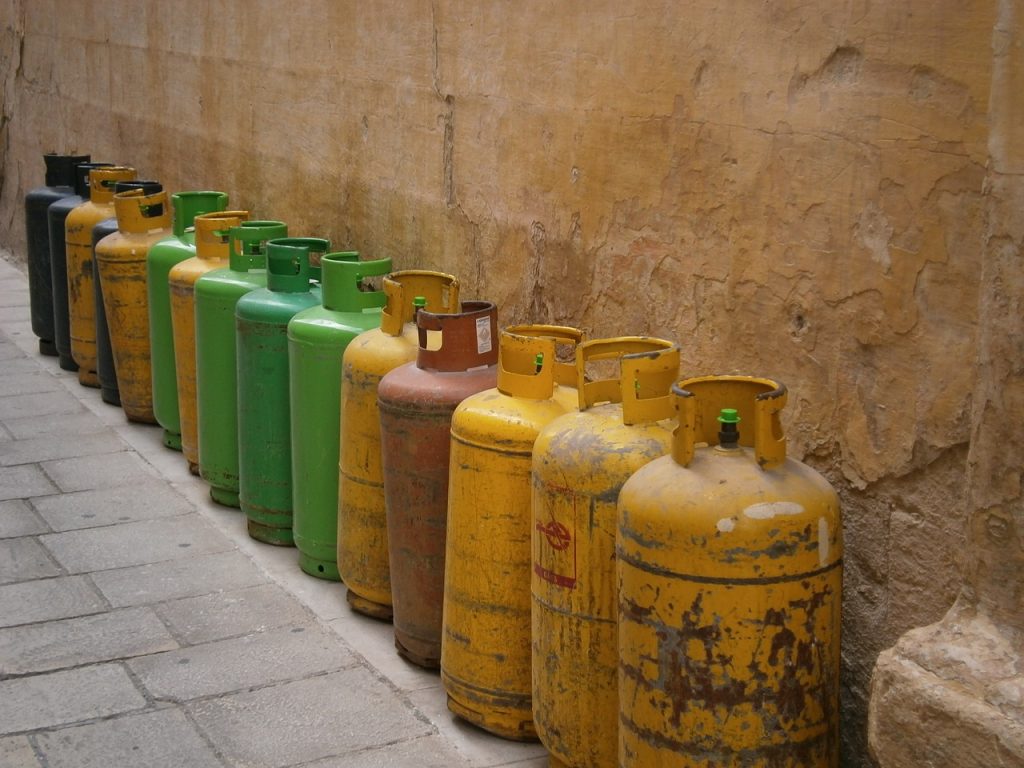Gas cylinders vs. gas canisters comparison
Gas cylinders and gas canisters both contain compressed gas for various industrial, commercial, and domestic purposes. However, there are significant differences between the two in terms of size, pressure capacity, portability, and storage.
Gas cylinders are typically larger and heavier than gas canisters with a capacity ranging from 5 to 50 liters or more. They require a separate regulator to control the flow of gas from the cylinder to the appliance or equipment. Gas cylinders come in different types such as propane, butane, oxygen, acetylene, carbon dioxide, and nitrogen depending on their specific application.
On the other hand, gas canisters are smaller in size usually weighing less than 1 kg with a capacity ranging from 100 ml to 1 liter. They are designed for portable use such as camping stoves or torches and often come with an integrated valve system that regulates the flow of gas directly to the appliance. Gas canisters are available in various sizes and types such as butane-propane mixtures or pure propane.
In summary, while both gas cylinders and gas canisters have their unique advantages depending on usage requirements; it’s essential always to follow safety guidelines when handling any compressed flammable gases.
Gas Cylinders: Large, refillable containers for gas
Gas cylinders and gas canisters are two common forms of containers that are used for transporting or storing various gases. While both these containers are designed to hold pressurized gasses, there are a few key differences between them.
A gas cylinder is a large, refillable container that is generally used for industrial applications. These cylinders are made from durable materials like steel or aluminum and can withstand high pressure. The gases stored in these cylinders include oxygen, acetylene, hydrogen, helium, nitrogen and propane. Typically, gas cylinders need special handling and transportation due to their size and weight.
On the other hand, a gas canister is a smaller disposable container that is often used for camping trips or outdoor activities where access to fuel sources may be limited. Unlike gas cylinders which require refilling after use; once empty, a gas canister needs to be disposed of properly. Due to their smaller size, they are much more portable than gas cylinders and easier to store in small spaces.
In conclusion, choosing between a gas cylinder or a gas canister depends on the intended use case scenario as well as the practicality required by the situation at hand. Both options have strengths and weaknesses according to usage conditions so it’s essential to choose wisely based on what best suits your own individual needs when handling volatile substances such as gases.
Types of Gas Cylinders: Standard, High-pressure, and LPG
Gas cylinders come in various types, including standard, high-pressure, and liquefied petroleum gas (LPG) cylinders. The standard gas cylinder is the most common type of cylinder used for industrial and medical gases. It is usually made of steel or aluminum with a maximum working pressure of 200 bar. They are typically used to store oxygen, nitrogen, argon, helium, and carbon dioxide.
High-pressure gas cylinders are designed to store gases at much higher pressures than standard cylinders. These cylinders can have a maximum working pressure of up to 300 bar and are commonly used for transportation purposes such as in diving tanks or firefighting equipment. Liquefied petroleum gas (LPG) cylinders are commonly used for domestic purposes like cooking fuel or heating homes. They contain a mix of propane and butane gases under pressure that turn into liquid when compressed.
Overall, it’s important to note that there is a difference between gas cylinders and gas canisters. Gas canisters are smaller portable containers often used for camping stoves or other recreational activities while gas cylinders are larger containers primarily intended for industrial use. Understanding the different types of gas cylinders available will help consumers choose the right one based on their specific needs and usage requirements while ensuring safe handling practices at all times.
Advantages of Gas Cylinders: Cost-effective, safe, eco-friendly
Gas cylinders are a cost-effective and convenient option for storing and transporting compressed gases. Compared to gas canisters, which are often disposable, gas cylinders are designed to be refilled multiple times, making them more economical in the long run. Additionally, gas cylinders come in a range of sizes to suit different needs and can be easily transported using trolleys or racks.
Safety is also a key advantage of using gas cylinders. They are built with robust materials that can withstand high pressures and impact damage, reducing the risk of accidents or leaks. Gas cylinders are also equipped with valves that allow for controlled release of gas, further enhancing their safety features. Furthermore, many types of gases stored in cylinders have low flammability or toxicity levels when handled properly.
Finally, the use of gas cylinders is considered eco-friendly compared to other options such as fossil fuels. Many industrial processes rely on compressed gases like nitrogen or oxygen that can be stored in cylinders rather than generated from non-renewable sources. Moreover, unlike disposable gas canisters that contribute to waste accumulation when discarded after use, empty gas cylinders can be taken back by suppliers for proper disposal or recycling purposes.
Gas Canisters: Small, disposable containers for gas
Gas canisters are small, disposable containers for gas that are commonly used in camping, hiking, and other outdoor activities. These canisters usually contain propane or butane gas and are designed to be lightweight and easy to carry. They come in various sizes ranging from 100g to 1kg and can be easily purchased at outdoor supply stores.
In comparison, gas cylinders are larger containers used for industrial or commercial purposes. These cylinders contain compressed gases such as oxygen, nitrogen or argon and require specialized handling equipment for transport and storage. Gas cylinders also have strict regulations regarding their use due to the potential hazards associated with their contents.
Despite being smaller and more convenient than gas cylinders, it is important to note that gas canisters still pose potential safety risks if not used properly. It is crucial to follow the manufacturer’s instructions when using these canisters and ensure they are stored in a well-ventilated area away from heat sources or open flames. Proper disposal of empty canisters is also essential as they may still contain residual amounts of hazardous gases.
Types of Gas Canisters: Butane and propane mixtures
Gas canisters are small, portable containers of pressurized gas used for camping stoves, lanterns, and other outdoor equipment. They come in various sizes and materials, but the two most common types are butane and propane mixtures. Butane canisters are typically used for indoor heating and cooking appliances as they burn with a clean blue flame that doesn’t produce much soot or smoke. On the other hand, propane mixtures are more commonly used for outdoor activities such as grilling or camping because they burn hotter than butane.
Butane canisters usually contain a blend of 70-90% butane gas and 10-30% propane gas. They have a low boiling point of around -1°C (30°F), which makes them ideal for use in moderate temperatures. However, they may struggle to perform well in colder weather conditions due to their lower vapor pressure. Propane mixtures typically contain a higher percentage of propane gas (at least 40%) which gives them a higher boiling point (-42°C/-44°F) than butane canisters. This allows them to function better in colder temperatures.
Both types of gas canisters have their own advantages and disadvantages depending on the situation. It’s important to choose the right type based on your needs before heading out on your next adventure!
Advantages of Gas Canisters: Portable, easy to use, convenient
When it comes to portable fuel sources for outdoor activities, gas canisters are a popular choice. These small, lightweight containers are easy to pack and carry, making them convenient for camping trips, backpacking expeditions, and other outdoor adventures. Unlike larger gas cylinders that require a separate regulator and hose system, gas canisters come equipped with their own self-sealing valves that make them simple to use.
In addition to their portability and ease of use, gas canisters also offer several other advantages over larger propane cylinders. For one thing, they tend to be more affordable than their bulkier counterparts. Gas canisters also produce less waste since they are designed for single-use rather than refillable like some propane tanks. They also take up less space in storage or transport which is especially important for those with limited space in their vehicles or homes. Overall, the convenience and affordability of gas canisters makes them an ideal option for anyone who needs a reliable source of fuel on-the-go.
Conclusion: Choose based on use case and preference.
In conclusion, when it comes to choosing a gas cylinder for your needs, it is important to consider both the use case and personal preference. CNShining, a leading manufacturer in the industry, offers a variety of gas cylinders that cater to different specifications and applications.
For instance, if you require a lightweight and portable gas cylinder for camping or outdoor activities, the company’s composite cylinders would be an ideal choice. However, if you are looking for a more durable option for industrial purposes such as welding or cutting metal, their steel cylinders would be more suitable. It is also important to consider factors such as capacity and pressure requirements before making your final decision.
Ultimately, personal preference plays a significant role in selecting the right gas cylinder. Some people may prefer composite cylinders due to their aesthetic appeal while others may opt for steel cylinders because they feel more sturdy.








